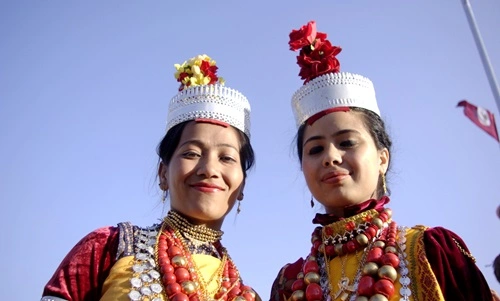If we were to talk about one of the most beautiful states in the country, without a single doubt, Meghalaya would be in the top ranks of that list. Why? Well, as many of you already know, it is known for its amazing greenery, scenic views, waterfalls, pleasant weather, living root bridges, and of course, the kind-hearted and loving people. Though, a big population of this state is a tribal population such as Khasi, Jaintia, and Garo tubes. To be honest, they all dress a certain way to preserve and show respect to their culture, and today, we’re about to take a good look at that. So, let’s just see what are the Traditional Dresses of Meghalaya, shall we?
Traditional Dresses of Meghalaya For Women
1. Khasi Women

Khasi women consider the Jainsem as the main or go-to type of attire, made of silk and falling from the waist to the heel. This is paired with a blouse and a cotton shawl called a Tap-Moh Khlieh. A Jainkup, in wool, is put on by many elderly women of the Khasi community. It provides warmth on festival occasions or very chilly days. On the grandest occasion like the Ka Shad Suk Mynsiem, the Khasi ladies wear beautiful Jainsem and Jainkup with gold embroidery, red coral necklaces, and shiny crowns.
2. Jaintia Women
The glorious outfit for Jaintia women is a velvet blouse with this long skirt called Thoh Khyrwang. They also put on checked cloth on their heads called Kyrshah during harvest season. Like the Khasi ladies, they adorn themselves with stunning gold and silver ornaments, especially on festive occasions.
3. Garo Women
Dakmanda is the major attire of Garo women. It doesn’t differ much from a lungi, which is wrapped around the waist. It is complemented by a blouse. In the far-off villages, they use a smaller cloth around the waist called Eking. But in the cities or busy places, they wear long cotton dresses.
Traditional Dresses of Meghalaya For Men
1. Khasi and Jaintia Men
Khasi and Jaintia men wear a long piece of unstitched cloth, which looks more like a dhoti. This they couple with a super-chic shirt or jacket, mostly bright with some embroidery. In festivals like Ka Pom-Blang Nongkrem or Ka Shad Suk Mynsiem, they also add a silk turban and carry the sword.
2. Garo Men
With a simple loincloth hand woven by themselves, Garo men do put on their simple loincloth. Having a passion for weaving most of the time, well, they take great pride in their hand-woven stuff. Mostly, this is worn during traditional ceremonies and festivals.
3. Wedding Attire in Meghalaya
On the important occasions of her life, Khasi and Jaintia brides wear a unique Jainsem or Dhara dress for the wedding. It is made of finer mulberry silk, yellow or saffron in hue, and soaked in innumerable streaks of cloth as gold or silver ornaments. They also wear a crown with a peak and look super awesome.
They wear a Jymphong kind of dress as grooms-a mile towards the cool sleeveless jacket. The whole creation has superbly classy embroideries on it and goes on with a red or yellow silk Jainboh (dhoti) shirt underneath it. To match or to top it all off, they all wear a turban called Jainspong that matches the bride’s look.
Jewelry and Ornaments
Jewelry is actually a significant part of the traditional touch of Meghalaya. Like, men and women wear special ornaments to celebrate festivals or weddings.
- Kynjri Ksiar: It is the pendant worn by Khasi and Jaintia women and is made from 24-carat gold.
- Paila: A necklace is formed of red coral beads, filled with wax (lac/laakh).
- Rigitok: A fine bead necklace worn by Garo men and women.
- Ripok: A lengthy bead necklace made of red glass or silver, which is usually worn by the Garo tribe.
- Jaksil: An elbow ring designed for rich Garo men during some special occasion.
- Nadongbi nr Sisha: Brass ring for the ear, which is mostly used by Khasi and Jaintia people.